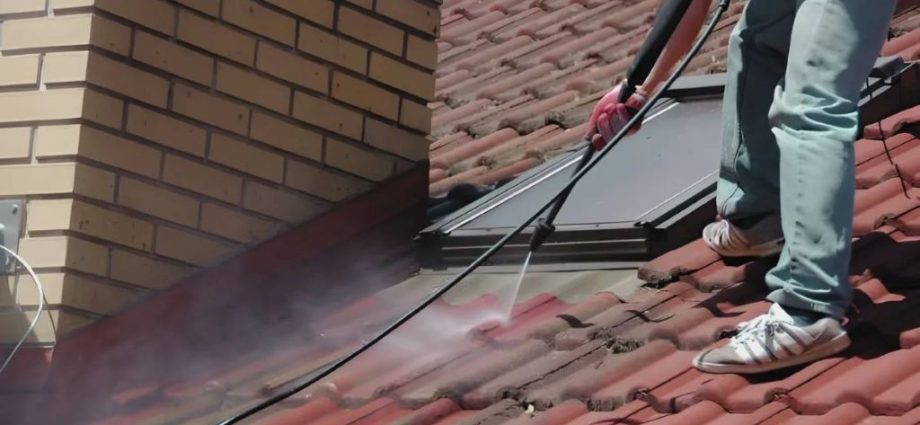Your roof is your home’s first line of defense against the elements, but over time, it can become a breeding ground for dirt, algae, moss, and debris. Not only does this buildup make your home look unkempt, but it can also cause long-term damage, leading to costly repairs. Enter roof pressure washing—a powerful solution to restore your roof’s appearance and extend its lifespan. In this comprehensive guide, we’ll explore everything you need to know about roof pressure washing, from its benefits to best practices, safety tips, and when to call in professionals. Whether you’re a homeowner looking to boost curb appeal or protect your investment, this article has you covered.
What is Roof Pressure Washing?
Roof pressure washing, also known as roof power washing, involves using high-pressure water jets to clean dirt, grime, algae, moss, lichen, and other contaminants from your roof’s surface. Unlike traditional cleaning methods, pressure washing delivers a deep clean that removes stubborn buildup without excessive scrubbing. This process is especially effective for asphalt shingles, metal roofs, and other durable roofing materials.
By removing harmful substances, roof pressure washing not only enhances your home’s aesthetic but also prevents damage that could compromise your roof’s integrity. However, it’s not a one-size-fits-all solution—different roof types require specific techniques to avoid damage, which we’ll cover later.
Why Should You Consider Roof Pressure Washing?
A clean roof does more than just improve your home’s appearance. Here are the key benefits of regular roof pressure washing:
- Prolongs Roof Lifespan: Algae, moss, and lichen can trap moisture, leading to rot, shingle deterioration, and leaks. Pressure washing removes these threats, helping your roof last longer.
- Boosts Curb Appeal: A clean, stain-free roof enhances your home’s overall look, making it more inviting and potentially increasing its market value.
- Prevents Costly Repairs: By addressing buildup early, you can avoid expensive repairs caused by water damage or structural issues.
- Improves Energy Efficiency: Dark stains from algae can absorb heat, increasing cooling costs. A clean roof reflects sunlight better, keeping your home cooler.
- Promotes Healthier Living: Mold and mildew on your roof can affect air quality, especially for those with allergies. Pressure washing eliminates these hazards.
When Should You Pressure Wash Your Roof?
Timing is critical when it comes to roof pressure washing. Here are some signs it’s time to clean your roof:
- Visible Stains or Discoloration: Black streaks, green moss, or white lichen are telltale signs of buildup.
- Moss or Algae Growth: These organisms thrive in damp, shaded areas and can spread quickly if not addressed.
- Debris Accumulation: Leaves, twigs, or dirt piling up on your roof can trap moisture and cause damage.
- Before Selling Your Home: A clean roof can make a strong first impression on potential buyers.
- After Severe Weather: Storms can leave debris and dirt that require immediate cleaning to prevent long-term issues.
For most homes, pressure washing every 2-3 years is sufficient, but this depends on your climate, roof material, and surrounding environment (e.g., areas with heavy tree cover may need more frequent cleaning).
Types of Roofs Suitable for Pressure Washing
Not all roofs are created equal, and some materials handle pressure washing better than others. Here’s a breakdown of common roofing materials and their compatibility with pressure washing:
- Asphalt Shingles: The most common roofing material, asphalt shingles can be pressure washed but require low-pressure settings (typically 1,500-2,000 PSI) to avoid dislodging granules.
- Metal Roofs: Durable and resistant, metal roofs can withstand higher pressure but may require specific nozzles to prevent scratches.
- Concrete or Clay Tiles: These materials are sturdy but can crack under excessive pressure. A professional approach with soft washing is often recommended.
- Slate Roofs: Slate is delicate and should only be cleaned by professionals using low-pressure or soft washing techniques.
- Wood Shingles: These are highly susceptible to damage from high-pressure washing and often require gentler methods.
Always consult with a professional to assess your roof’s condition and material before starting any cleaning project.

Soft Washing vs. Pressure Washing: What’s the Difference?
While pressure washing uses high-pressure water to blast away dirt, soft washing combines low-pressure water with specialized cleaning solutions to gently remove stains and organic growth. Soft washing is often safer for delicate roofing materials like asphalt shingles or slate, as it minimizes the risk of damage.
When choosing between the two, consider:
- Roof Material: Delicate materials like asphalt or slate benefit from soft washing.
- Type of Buildup: Heavy moss or lichen may require soft washing with eco-friendly cleaning agents.
- Budget: Soft washing may cost more due to the use of specialized solutions.
For most homeowners, a combination of both techniques—pressure washing for durable surfaces and soft washing for sensitive areas—yields the best results.
How to Pressure Wash Your Roof Safely
If you’re considering a DIY approach, safety and proper technique are paramount. Here’s a step-by-step guide to pressure washing your roof:
-
Gather the Right Equipment
- Pressure Washer: Choose one with adjustable PSI settings (1,500-2,500 PSI for most roofs).
- Nozzles: Use a wide-angle nozzle (25-40 degrees) to distribute pressure evenly.
- Safety Gear: Wear non-slip shoes, safety goggles, gloves, and a harness for steep roofs.
- Cleaning Solutions: Use eco-friendly, roof-safe detergents for soft washing or stubborn stains.
- Ladder: Ensure it’s stable and rated for your weight.
-
Prepare Your Roof
- Clear debris like leaves and twigs manually or with a leaf blower.
- Cover nearby plants, windows, and vents with tarps to protect them from water or cleaning solutions.
- Check for loose shingles or damage and repair them before washing.
-
Apply Cleaning Solution (Optional)
For algae or moss, apply a biodegradable cleaning solution and let it sit for 10-15 minutes to loosen the buildup.
-
Start Pressure Washing
- Begin at the top of the roof and work downward to prevent water from seeping under shingles.
- Keep the nozzle at a 45-degree angle and maintain a distance of 6-12 inches from the surface.
- Use sweeping motions to avoid focusing pressure on one spot for too long.
-
Rinse and Inspect
- Rinse thoroughly to remove all cleaning solutions and debris.
- Inspect your roof for any missed spots or damage.
-
Clean Up
- Remove tarps and clean any overspray from windows or siding.
- Dispose of debris responsibly.
Safety Tip: Never pressure wash on a wet or windy day, as this increases the risk of slipping or losing control of the equipment.
Common Mistakes to Avoid
Roof pressure washing seems straightforward, but mistakes can lead to costly damage. Here are pitfalls to watch out for:
- Using Too Much Pressure: High PSI can strip granules from shingles or crack tiles.
- Skipping Safety Gear: Falls are a leading cause of injury during roof cleaning.
- Using Harsh Chemicals: Non-roof-safe cleaners can damage materials or harm plants.
- Ignoring Roof Condition: Pressure washing a damaged roof can worsen leaks or cracks.
- DIY Without Experience: Complex roofs or heavy buildup are best left to professionals.
When to Hire a Professional Roof Cleaning Service
While DIY pressure washing can save money, certain situations call for professional expertise:
- Steep or High Roofs: Professionals have the equipment and training to work safely at heights.
- Delicate Materials: Slate, wood, or older asphalt roofs require specialized care.
- Heavy Algae or Moss: Professionals use advanced techniques like soft washing for thorough removal.
- Time Constraints: Hiring a service saves you time and effort.
When choosing a roof cleaning company, look for:
- Licensed and insured contractors.
- Experience with your roof type.
- Positive customer reviews and transparent pricing.
- Use of eco-friendly cleaning solutions.
Environmental Considerations
Pressure washing can use significant water and cleaning solutions, so consider eco-friendly practices:
- Use biodegradable, non-toxic cleaners to protect plants and waterways.
- Opt for low-flow pressure washers to conserve water.
- Hire professionals who prioritize sustainable practices.
How Much Does Roof Pressure Washing Cost?
Costs vary based on roof size, material, and location. On average:
- DIY: $100-$300 for equipment rental and supplies.
- Professional Services: $300-$800 for a standard home, with higher costs for larger or complex roofs.
Get multiple quotes and ensure the service includes a warranty or satisfaction guarantee.
Conclusion: Take Action for a Cleaner Roof
Roof pressure washing is a game-changer for maintaining your home’s appearance, value, and structural integrity. By removing harmful buildup and preventing damage, this simple maintenance task can save you thousands in repairs while boosting curb appeal. Whether you tackle it yourself or hire a professional, the key is to act before small issues become big problems.
Related Topics:


Comments are closed, but trackbacks and pingbacks are open.